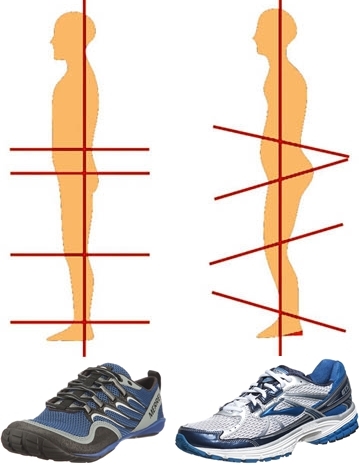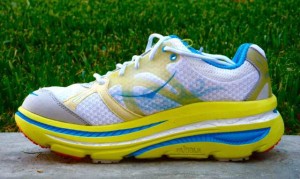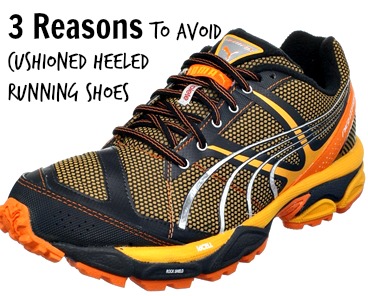For the forefoot runners who struggle with injury —zero drop running shoes will help! I have been there and wearing running shoes with an elevated heel will not help you prevent injuries. Here are 3 reasons why.
3 Reasons Forefoot Runners Should Avoid Cushioned Heeled Running Shoes
1. Globally Impairs Posture
Forefoot running is useless for preventing injuries if a heeled running shoe is worn because these shoes grossly alter posture and biomechanics.

- Several investigations found that heeled running shoes increased ankle dorsiflexion, anterior pelvic tilt, trunk extension, and neck and shoulder posture may become altered as well.
To make running gait as efficient and stable as possible in these shoes, greater neuromuscular strategies compensate for the postural alterations, and therefore, more energy is expended. This jives with reports that associated heeled running shoes with a higher metabolic cost compared to minimalist running shoes.
2. Alters Center of Mass
Another downfall to forefoot running in heeled running shoes is that the vertical position of the center of mass (COM) becomes elevated, resulting in greater gait instability.
- If the COM is higher relative to the ground, this may lessen the spring-effect of the leg during forefoot running, therefore more muscular output would be required to compensate for the loss of elastic work from the lower leg.
3. Heavy Foot Strike
Many researchers agree that under-heel cushioning encourages a heavier foot strike which also increases global plantar pressures. Over time, repetitive exposure to high plantar pressures while running has deleterious effects on foot health such a causing a metatarsal stress fracture.

Minimalist and Barefoot Running is Best
Past reports have shown that during running, flat thin cushioned running shoes or running barefoot minimizes plantar pressures by encouraging a forefoot strike — a lighter foot strike compared to a heel strike.
Minimalist shoes are also more flexible than most cushioned heeled running shoes which is absolutely critical and essential for maintaining intrinsic foot strength and improving load redistribution to the toes. The importance of this too, is that flexible shoes allow mechanical stimuli to surge whereby increased muscle strength reflects the heightened mechanical stimuli.
Forefoot running in a minimalist running shoe also lowers the COM, thereby increasing spring-compression on the lower leg, allowing greater storage and release of elastic strain energy
- Since minimalist shoes lowers the COM during running, neuromuscular strategies are minimized because being closer to the ground allows for greater stability during running..
Running forefoot properly is all about the proper footwear (or lack-thereof). Be sure to check out my reviews on zero drop running shoes. In the meantime, stop by my Facebook page, where I talk about topics related to forefoot running, barefoot running, on a daily basis.
More From Run Forefoot:
See What a Proper Forefoot Strike Looks Like
Proper Biomechanics Depends Largly on Proprioception
How to Maintain Your Forefoot Strike
Comparing/Contrasting Heel Strike and Forefoot Strike Running
Bretta Riches
BSc Neurobiology; MSc Biomechanics candidate, ultra minimalist runner & founder of RunForefoot. I was a heel striker, always injured. I was inspired by the great Tirunesh Dibaba to try forefoot running. Now, I'm injury free. This is why I launched Run Forefoot, to advocate the health & performance benefits of forefoot running and to raise awareness on the dangers of heel striking, because the world needs to know.
Latest posts by Bretta Riches (see all)
- Can You Run In Barefoot Shoes? Yes, But DON’T Heel Strike! - 21/07/2024
- Why Cushioned Running Shoes Are Really Bad for Your Feet - 19/07/2024
- Do Cushioned Running Shoes Cause Injuries? - 17/07/2024


Leave a Reply